Content
Home growing of mushrooms is becoming more and more popular every year. Unfortunately, not all varieties of mushrooms can be bred in this way, some of them are too capricious to the surrounding conditions, others require serious financial investments. Based on this, before you start mushroom growing on your own, you need to find out what mushrooms are grown at home. Most often these are the following types:
- Champignons (all varieties), volvariella, ringlet, raincoat, dung beetle. These are soil fungi, usually they grow in fields or meadows in the humus layer of the soil.
- Porcini mushrooms, chanterelles, boletus, boletus, truffles, morels, mushrooms. These are mycorrhizal fungi that form a symbiosis with the roots of only certain trees. They are artificially grown from purchased mycelium (mycelium is sprouted mushroom spores that are placed in a substrate), but it is rather difficult to breed these types at home.
- Oyster mushroom (all types - common, royal, pink, lemon), honey mushrooms (winter, summer, poplar, marble), gericium, tinder fungus, shiitake. These types of fungi grow on the wood of dead trees or plant debris containing cellulose.
The most unpretentious of all and the easiest to grow at home are oyster mushrooms, shiitake, winter mushrooms, mushrooms and ringlet.
All of these species have certain requirements for the conditions of detention. It remains only to figure out which ones.
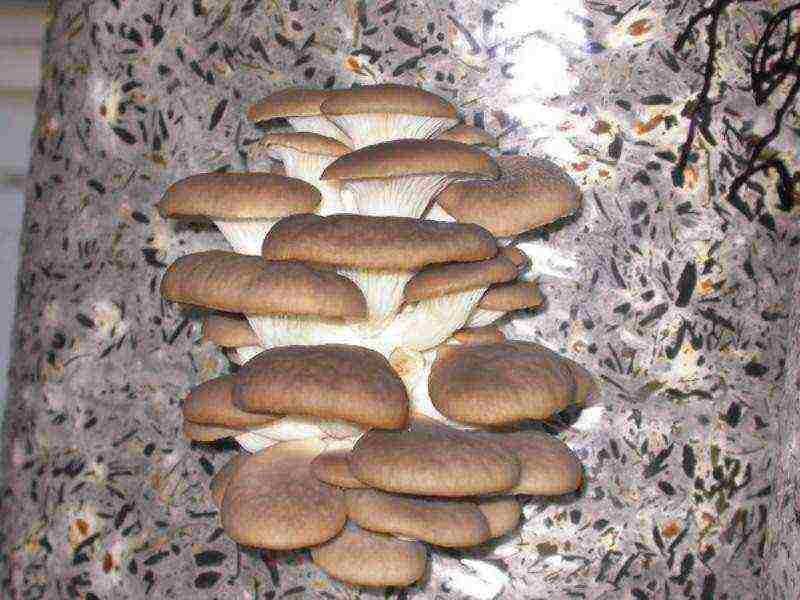 Oyster mushroom is in the first place in terms of prevalence and ease of cultivation. For novice mushroom growers, experienced entrepreneurs who have been engaged in mushroom growing for a long time offer to start growing mushrooms from it. When artificially growing oyster mushrooms, costs are required less than for all other mushrooms. Oyster mushroom is distinguished by unpretentiousness, excellent taste, early maturity, excellent yield, high resistance to viruses and bacteria, as well as rather long shelf life. Oyster mushrooms are grown in plastic bags (with a substrate, mushroom mycelium and bio-additives), on hemp, sawdust of various trees, straw, husk, corn stalks. Mushrooms grow well in rooms with a humidity of 80-85% and at fairly wide temperature ranges (from 10 to 30C, average values 16-20C). The first harvest of mushrooms can be cut after 30 days (in winter after 45). From one mushroom block at a time, it turns out to remove an average of 2.5-3 kg of the crop. At the same time, serve 100 blocks on an area with an area of 30 sq. m. without problems even one person can. Mushrooms produce a harvest for 5 years.
Oyster mushroom is in the first place in terms of prevalence and ease of cultivation. For novice mushroom growers, experienced entrepreneurs who have been engaged in mushroom growing for a long time offer to start growing mushrooms from it. When artificially growing oyster mushrooms, costs are required less than for all other mushrooms. Oyster mushroom is distinguished by unpretentiousness, excellent taste, early maturity, excellent yield, high resistance to viruses and bacteria, as well as rather long shelf life. Oyster mushrooms are grown in plastic bags (with a substrate, mushroom mycelium and bio-additives), on hemp, sawdust of various trees, straw, husk, corn stalks. Mushrooms grow well in rooms with a humidity of 80-85% and at fairly wide temperature ranges (from 10 to 30C, average values 16-20C). The first harvest of mushrooms can be cut after 30 days (in winter after 45). From one mushroom block at a time, it turns out to remove an average of 2.5-3 kg of the crop. At the same time, serve 100 blocks on an area with an area of 30 sq. m. without problems even one person can. Mushrooms produce a harvest for 5 years.- Champignons occupy the next place in terms of the popularity of cultivation, both in an industrial economy and at home. They are much more demanding on the conditions of detention. And the technology of growing them is more expensive than breeding oyster mushrooms. Mushrooms are grown in bags or boxes with soil, in which the mycelium is laid. Champignons grow well in dark, cool rooms (12-18C, maximum value no more than 28C) with a humidity of 65-85%. The first harvest of mushrooms is ready for harvest in 45-50 days, and the next ones can be harvested within 3 months.
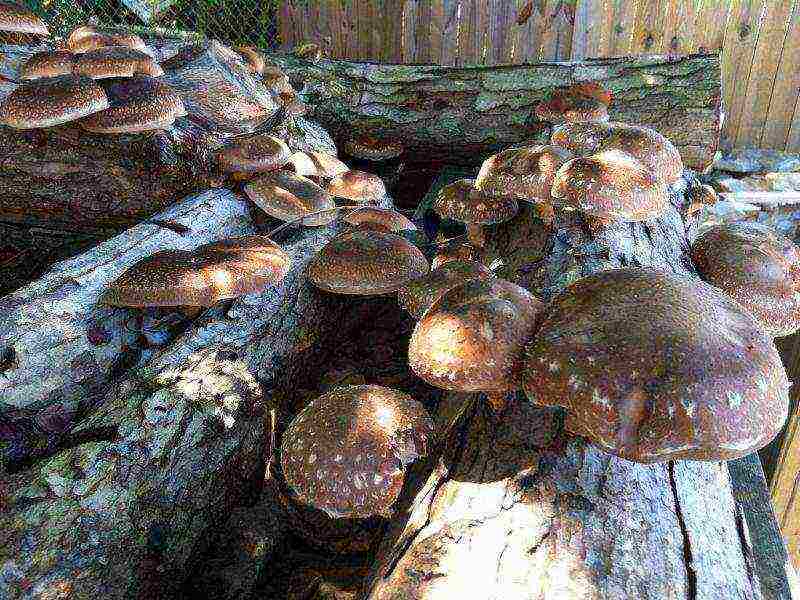 Shiitake - not only tasty, but also a very healing mushroom (successfully used in the treatment of cancer).Until a certain point, it was grown only in Asian countries. Shiitake is one of the most expensive mushrooms (the price is about $ 50 per 1 kg). Grows well at an average temperature of 12C. It is grown on sections of wood and on various substrates. It is important to know that in order to get a harvest of really tasty and healthy shiitake, the mycelium for breeding must be purchased from Japan or China, but not European, because it is spoiled by selection. The first harvest usually begins only in the next year and will last up to three years.
Shiitake - not only tasty, but also a very healing mushroom (successfully used in the treatment of cancer).Until a certain point, it was grown only in Asian countries. Shiitake is one of the most expensive mushrooms (the price is about $ 50 per 1 kg). Grows well at an average temperature of 12C. It is grown on sections of wood and on various substrates. It is important to know that in order to get a harvest of really tasty and healthy shiitake, the mycelium for breeding must be purchased from Japan or China, but not European, because it is spoiled by selection. The first harvest usually begins only in the next year and will last up to three years.- Winter honey - mushroom quite resistant to cold, grows well at ambient temperatures of 1-2 ° C. This mushroom has a pleasant taste and good nutritional value. It perfectly adapts to parasitizing on trees with living wood, and for this reason it should not be grown in backyard gardens or vegetable gardens, it is recommended to grow only on substrates and log cabins indoors.
- Koltsevik - not very well-known mushroom. Its cultivation began relatively recently, only about 25 years ago. This mushroom outwardly resembles a boletus, and in taste competes with champignons. It is grown on a personal plot directly on open ground beds or in plastic bags and boxes.
By becoming familiar with which mushrooms are grown at home, choosing a certain type for yourself and following the rules of caring for them, you will receive a constant tasty source of nutrients.
There are more than enough mushroom lovers in our country! Only for a hike into the forest for a "quiet hunt" you need the accompanying weather and certain climatic conditions. Not everyone will think about growing mushrooms at home, and even almost on an industrial scale. Most consider this to be fantastic. However, everything is real. And we will tell you how to grow mushrooms in a greenhouse or at home.
What mushrooms can be grown at home
The very idea of growing mushrooms at home poses a choice of a specific species. All varieties suitable for home breeding do not need special material costs or additional efforts. The only exceptions are champignons, but an experienced gardener will cope with this problem too. The choice must be made, first of all, based on the desired profit. All varieties of mushrooms suitable for growing at home can be classified into two main types:
- woody;
- soil.
The former include the well-known shiitake mushrooms, oyster mushrooms, and winter mushrooms. But to the second - no less popular mushrooms and ringlets. Even with small areas, the harvest can be excellent. That is why these varieties are recommended for growing on an industrial scale.
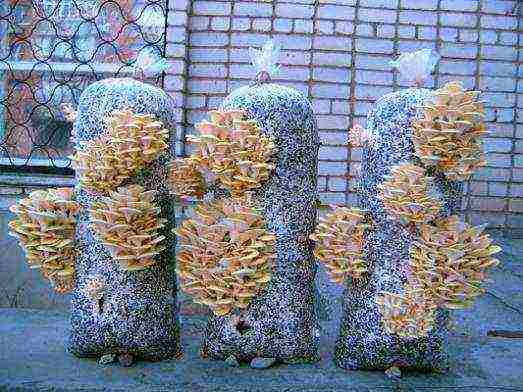 Growing oyster mushrooms at home on the balcony
Growing oyster mushrooms at home on the balcony
Growing technology for beginners
The bulk of the time it takes to grow mushrooms is spent creating mycelium. However, the advice of experienced mushroom growers suggests that it is better to grow this material on your own. After all, even the best and trusted suppliers fail from time to time. Mycelium can be grown in two ways:
- in the grain substrate;
- on wooden sticks.
The choice depends on what kind of mushrooms you plan to grow.
 Growing mushrooms on a nutritious substrate
Growing mushrooms on a nutritious substrate
Breeding mycelium
The mycelium is grown in a specific substrate. It is recommended to make sure that its chemical and mineral composition is as similar as possible to that in which mushrooms grow naturally. The composition of this medium must be selected again, depending on the type of mushrooms being grown.
For example, shiitake mushrooms feel more comfortable in wood, mushrooms - in compost, but oyster mushrooms prefer straw. With proper care, chopped straw and sawdust can yield any of these types of mushrooms. However, the substrate must be of high quality. This is ensured by its dryness, absence of mold, as well as unpleasant odors and foreign impurities.
Wheat straw is best suited for growing mushrooms. You can also use rye or barley. Oyster mushrooms are allowed to be propagated in sunflower husks. However, only fresh material should be used, since pathogenic bacteria can grow excellently in old ones.
The mycelium is the backbone of a large number of germinated fungal spores. As soon as this base is placed in the substrate, the process of active growth begins. Initially, only the appearance of thin filaments can be observed, which eventually turn into edible mushrooms.
 Mushroom mycelium
Mushroom mycelium
It is worth purchasing high-quality planting material only in specialized stores. Priority should be given to wood containing viable fungal spores. They will be more resistant to disease. Not planted from grain mycelium. Ordinary mushroom spores can also be purchased. Only in this case it will take more time and effort to grow your crop. The procedure will resemble the cultivation of any crop from seed. It is better for beginners to avoid this method.
To obtain the maximum yield, it is necessary that the mycelium spreads as thoroughly as possible in the compost. To do this, you need to keep the planting warm. They can be heated using a special electric pillow. Heat is needed only during the incubation period. Once the mushrooms are in the growing phase, it is best to keep them cool. A glazed and insulated balcony is well suited for this.
When growing mushrooms in residential premises, it is necessary to avoid the phase of their ripening. Otherwise, the spores released into the air can provoke allergic reactions and even asthma.
As a rule, seedlings appear in the third week after planting the mycelium. Readiness for harvesting is determined by the hat. You need to cut off ready-made mushrooms only with a knife, so as not to injure those that are still in the soil and are just preparing to give a crop. The ready-made collection can be used both immediately and after preliminary freezing.
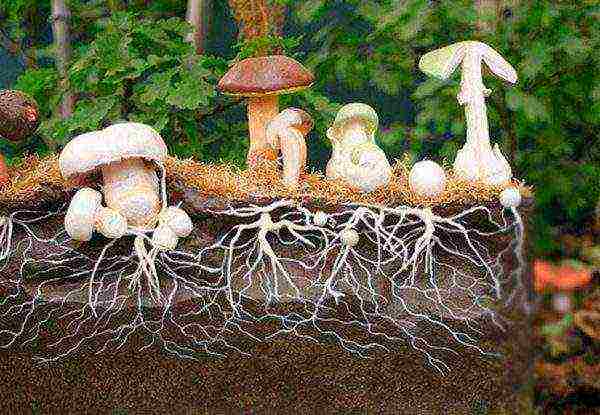 Sectional diagram of mushroom growth from mycelium
Sectional diagram of mushroom growth from mycelium
Other ways to grow mushrooms at home
In addition to the main ones, there are also additional ways of growing mushrooms. True, they do not bring such a large-scale result and are used mainly by children as experiments. For example, some types of mushrooms can be grown on logs. For this logs up to half a meter long are cut from hardwood. This must be done at least 2 weeks before settling with mycelium.
In the resulting blank, holes are made in a checkerboard pattern at a distance of 10 cm. After that, the sticks with mycelium must be sealed. A hammer can be used for this procedure.
Before starting work, you must disinfect your hands and make sure that there is no debris in the holes.
The logs filled with mycelium are placed in the basement and wait until it fills the entire space. The procedure is lengthy and can take up to 1 year. Temperature and humidity are considered key conditions.
A known method of growing mushrooms on coffee grounds. It contains many trace elements:
- manganese;
- potassium;
- magnesium;
- nitrogen.
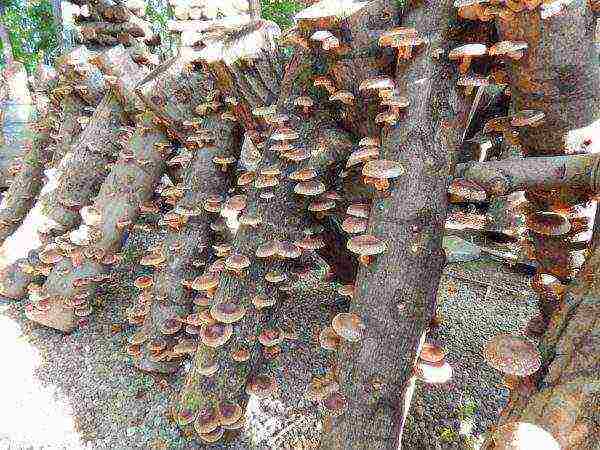 Growing mushrooms on stumps
Growing mushrooms on stumps
This environment is ideal for oyster mushrooms. In addition, the coffee grounds do not need to be sterilized again. The disadvantage of this method is that it is very difficult to get a large amount of freshly drunk cake at home. We'll have to ask him at the nearest cafe. The growing container can be regular freezer bags or ice cream containers.
The mycelium must be mixed with the cake, and then the container must be tightly closed. It can be stored under the sink. Germination time will be about 1 month. Once the surface is white, cut a small hole in the top of the bag. Through it, it is necessary to spray with water 2 times a day. After a week, you can see how small mushrooms begin to grow.
Growing porcini mushrooms and other species at home for beginners is a very exciting and useful activity. The needs of your family can be fully satisfied, even without special skills and large areas. The main thing is patience and a desire to see the result. After all, you can grow them all year round!
3 parts: Basic growing method Growing mushrooms on coffee grounds Alternative growing methods
Growing mushrooms at home is a task that anyone interested in growing food for their own consumption should tackle at least once. Mushrooms are a beneficial addition to any diet because they are low in calories and fat, but high in fiber and potassium. Plus, they're easy to grow at home. Mushrooms are best grown in an area where temperature and conditions are easy to manage. Knowing how to grow mushrooms at home will help you carefully manage your growing conditions.
Part 1 The main method of growing
-
 Choose the type of mushroom to grow.
Choose the type of mushroom to grow.
There are 3 types of mushrooms that are easiest to grow at home: oyster mushrooms, champignons and shitaki. The cultivation method for each type of mushroom is similar, but the ideal growing medium is different.
- Oyster mushrooms are best grown in straw. Shiitaks grow better on deciduous sawdust, and mushrooms grow on compost manure. These different nutrient media reflect the different nutritional needs of each species. However, each of the 3 species is easy enough to grow in sawdust or straw.
- The choice of mushrooms for growing is a matter of taste. You need to grow the mushroom that you want to eat.
-
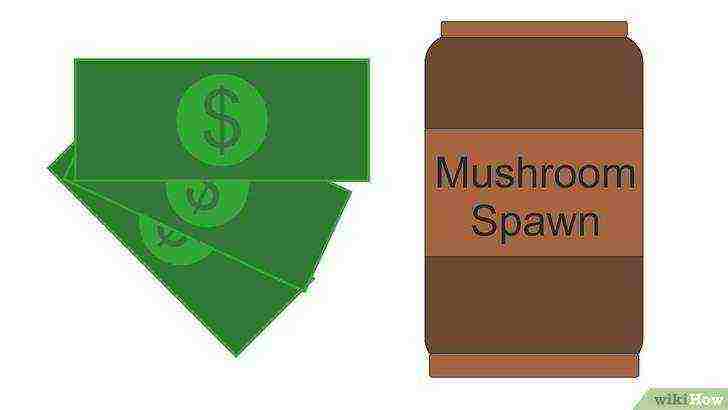 Buy mycelium.
Buy mycelium.
Myceliums are sawdust permeated with fungal mycelium - in fact, the root structure of the fungus. They are used as seedlings of plants to promote growth.
- You can buy high quality mycelium from your online store, gardening store, or other specialty organic store.
- Buy the mycelium, not the spores. Some stores also sell spores that look more like plant seeds (rather than seedlings). Growing mushrooms from spores takes more time and practice and is best suited to a seasoned mushroom grower.
- Sterilize the culture medium.
If you grow mushrooms in straw or sawdust, you must sterilize this substrate before sowing the mycelium. This is done in order to kill any microorganisms that might compete with the mycelium.
- To sterilize the medium, place it in a heat-resistant bowl and add enough water to make the straw or sawdust damp. Place the bowl in the microwave and heat it on high power for two minutes or until the water has boiled away.
- This kills all microorganisms, making it a safe breeding ground for mycelium to be accepted. You may have to work in batches to sterilize all straw or sawdust completely.
- Heat the substrate to spread the mycelium in it.
The mycelium must be thoroughly spread in a nutrient medium for the mushrooms to grow. Warm temperatures stimulate growth.
- After choosing a substrate for your mushroom species, place a few handfuls of it in a baking sheet. A shallow baking sheet with a large surface area is ideal for growing mushrooms.
- Stir the mycelium into the substrate with a sterilized spoon or similar. Place the baking sheet on an electric pillow set at 21 ° C. This is the ideal temperature to stimulate growth.
- Leave the unit in a dark environment such as a closet for three weeks.This will allow the mycelium to spread in the nutrient medium.
- Place the substrate in a suitable location.
After three weeks, place the substrate in a dark and cool place (about 13 ° C). As a rule, a basement is suitable for this, but in winter, a closet or drawer in an unheated room will do.
- If you notice green or brown spots on the substrate (like moldy bread), remove the spots and discard.
- Pour a handful of soil onto the substrate and sprinkle everything with enough water to thoroughly wet. You can cover the baking sheet with a damp towel to prevent moisture loss.
- You can place a low heat lamp next to the baking sheet. It will replace the sun, and the mushrooms will begin to reach for it and grow upward, which will further facilitate their collection.
- Keep the mixture moist and cool while the mushrooms are growing. Check it periodically and spray with water as needed.
- Mushrooms prefer coolness. The most important thing is not to let them overheat. At temperatures below 21 ° C, the mushrooms should grow excellently.
- Harvest when the mushrooms are fully grown.
After about three weeks, you will have small mushrooms. Maintain moisture, coolness, and darkening to encourage their growth.
- When the mushroom caps are completely detached from their legs, they can be collected. You can pick mushrooms with your fingers, but you risk damaging newly developing mushrooms below the surface. Better to use a sharp knife to cut the mushrooms at the base of the stem.
- Rinse the mushrooms before cooking. The harvested mushrooms can be stored in a paper bag in the refrigerator for up to seven days.
Part 2 Growing mushrooms on coffee grounds
-
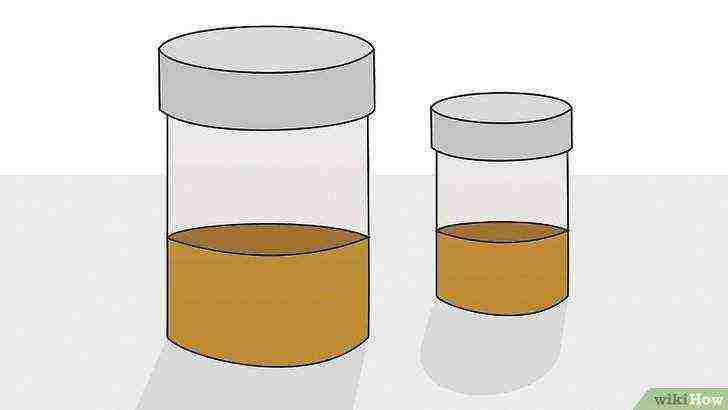 Take out the coffee grounds.
Take out the coffee grounds.
Growing mushrooms from coffee grounds is an interesting project that reuses coffee grounds that would otherwise go to waste. Coffee grounds are an excellent breeding ground for mushrooms (in particular oyster mushrooms), as they are already sterilized during the coffee brewing process and are full of nutrients.
- For 500 g of mycelium, you will need 2.5 kg of fresh coffee grounds. The best way to get that much fresh coffee grounds (brewed on the same day) is in a café and kindly ask. Most likely, they will gladly give it to you.
-
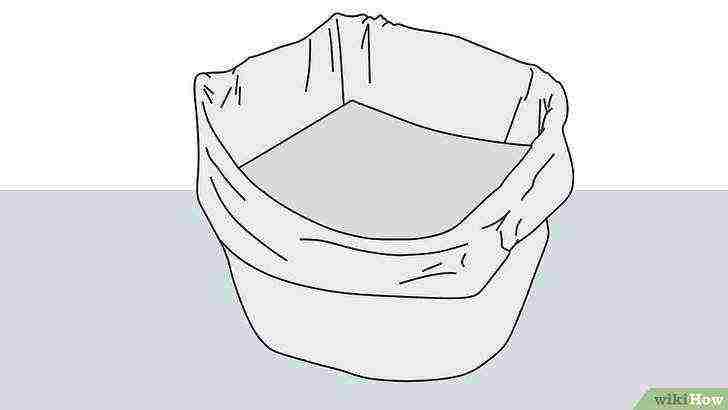
Find a container for mushrooms. It is best to use a special filter bag that can be purchased with the myceliums. If not, you can use a large airtight freezer bag, a cleaned milk carton, or an ice cream carton with four holes punctured in the sides.
-
Transfer the mycelium to a container. Wash your hands thoroughly with antibacterial soap, then stir the mycelium into the coffee grounds, crushing it with your hands to distribute it evenly. Place the planted coffee grounds in a plastic bag or container and seal tightly.
- Place the mycelium in a suitable environment.
Place the bag or container in a warm, dark place between 18 and 25 ° C, such as under a sink. Leave it on for about three to four weeks until the contents are completely white due to the mycelium settling in the coffee grounds.
- If green or brown spots appear on the substrate, cut them out to avoid poisoning later.
-
Move the mushrooms. When the contents of the bag or container are completely white, move it to a bright place (but not in direct sunlight) and cut a 5x5 cm hole on top.Moist the contents of the container by watering it twice a day to prevent drying out - the mushrooms will not grow too dry conditions.
- Harvest the mushrooms.
Over the next five to seven days, the tiny mushrooms will start to sprout. Keep hydrating them with water and they will double in size daily. When the mushroom caps begin to curl slightly upward, they can be collected.
- When the mushrooms stop sprouting, plant coffee grounds in your garden, cover with bark mulch or compost, and new mushrooms may sprout depending on the weather.
Part 3 Alternative cultivation methods
-
 Grow mushrooms from the kit.
Grow mushrooms from the kit.
Growing mushrooms from a ready-made kit is a fun and easy way for beginners. Such kits usually consist of plastic bags filled with sterilized and seeded straw or soil. All you need to do is store the bag in the right conditions for seven to ten days until you have your homegrown mushrooms.
- The sets usually contain the most common varieties of mushrooms such as champignons, shiitake and oyster mushrooms.
- To start growing, simply open the bag and place it in a well-lit area out of direct sunlight, such as a shaded window sill. The kit can be kept at room temperature, but it needs to be moistened daily with water to keep the humidity high. Some kits have plastic tarps to cover the bag and keep the humidity level.
- Mushrooms will begin to sprout after seven to ten days, but within three months they may suddenly start growing two or three more times.
- After you have collected all the mushrooms, you can bury the substrate with mycelium in the garden, sprinkle with bark mulch, or in a compost heap. Then, depending on the weather conditions, the mushrooms will start growing in this place.
- Grow mushrooms on a log.
Another interesting way to grow certain types of mushrooms - such as reishi, ram mushroom, shiitake, oyster mushrooms - on a log. Birch plugs, completely sown with mycelium, are stuck into a piece of log. Stoppers can be obtained online and from specialized mushroom spore suppliers.
- The first thing to do is find a suitable log for growing mushrooms. You will need non-scented deciduous logs such as maple, poplar, oak, or elm. They should be 90-120 cm long and no more than 35 cm in diameter. Cut them out at least two weeks before clogging in order to destroy the natural antifungal properties of the tree.
- To "populate" a piece of log 90-120 centimeters long, you will need about 50 plugs. Use a 5/16 ″ drill to insert the plugs. Make holes 5 cm deep throughout the log in a staggered manner. The distance between them should be about 10 cm. Insert birch plugs into the holes and hammer them in to seal them completely.
- If you plan to leave the log outdoors, you will need to seal the holes with cheese wax or beeswax to protect the plugs from insects and harsh weather. If you will be storing the log at home, in a garage or basement, this is not necessary.
- Over time, the mushroom mycelium will spread on the birch corks throughout the log until the entire piece of wood is inhabited. After complete settlement, the mushrooms will begin to sprout from the cracks in the log. This usually takes 9-12 months, but depending on the temperature and humidity, the mushrooms should reappear from year to year.
Tips
- For more information on growing mushrooms at home and outdoors, read this article.
What do you need
- Mycelium
- Straw, sawdust or manure
- Baking tray
- Heating pad
- Potting soil
- Sprinkler
- Water
- Towel
Article Information
This page has been viewed 82,589 times.
Was this helpful?
To fry mushrooms or cook a fragrant soup, it is not necessary to wear rubber boots and a raincoat, and go to the forest for a "quiet" hunt.
Mushroom "clearing" in the form of shelves can be arranged in your own cellar, the main thing is to know what mushrooms can be grown artificially.We will find out which varieties are easily grown at home, are distinguished by their unpretentiousness and excellent taste.
What mushrooms are grown artificially
Soil mushrooms
- Ring piece. A mushroom that looks like a boletus. Grown in boxes, plastic bags and outdoors, like a vegetable in the garden. In terms of taste, the ringlet is in no way inferior to champignons.
- Champignon. Gourmet mushroom grown both at home and on an industrial scale. It has an excellent aroma and is appreciated for its excellent taste. It is used in cooking in many dishes: appetizers, salads, hot dishes, sauces, etc. Champignons are grown in bags and boxes.
Useful article: "How to grow mushrooms at home"
 Champignons are grown in bags and boxes
Champignons are grown in bags and boxes
Tree mushrooms
- Oyster mushroom... A popular mushroom that is easy to grow and therefore ideal for those new to mushroom farming. Unpretentious oyster mushroom gives large yields, is resistant to pathogenic bacteria, excellent taste and rather long shelf life. It is grown on stumps, logs or in plastic bags.
- Shiitake... Healing Mushroom - An antioxidant (used in cancer treatment) with an exquisite taste. It is grown on various substrates and wood. If it is a medicinal mushroom that needs to be grown, it will need a real mycelium, not subjected to selection, - Japanese or Chinese production.
- Winter honey agaric. A valuable nutritious mushroom that is not afraid of cold weather (it can grow at a temperature of 1-2 ° C) and has a wonderful taste and aroma. Grown in basements on wood and various substrates.
Now that you know what mushrooms can be grown artificially, you can safely join the ranks of mushroom growers and grow your favorite mushrooms with your own hands!


